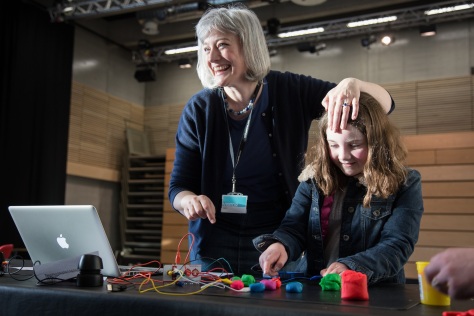We’re delighted to bring you our first guest blog post, from poet Elspeth Murray:
I am lucky to work sometimes as a poet in schools and other times with Puppet State Theatre Company. So I was delighted to be invited to work on a project that combines my love of poetry with one of the most fabulous puppetry productions EVER, War Horse.
So how do poetry and Play-Doh come together? Rather than involving rolling pins and nursery rhymes, this is about using cutting-edge technology to put war poetry at the fingertips of 10 and 11 year olds in some of the least privileged parts of Edinburgh.
War Horse came to Edinburgh’s Festival Theatre in February 2014 and among the many thousands who packed out the theatre for the sell-out run were twelve classes from four primary schools in Pilton and Muirhouse.
As well as the live performance, each of these mostly P6 and P7 classes also had the benefit of follow-up workshops from professional arts practitioners in song-making (Dave Boyd), movement (Skye Reynolds), shadow-puppetry (Arran Howie) – and poetry (me, Elspeth Murray).
My input came more or less at the end of the project. The magic of the story and the variety of activities that they had already done in response made my job a lot easier. I have rarely worked with young people who were so enthusiastic about a project.
I encouraged them to write concise descriptions of things they saw and heard in the story: the horses, the battlefields, the hospitals, the farm, and the seasons that passed as the tale of friendship, loss and survival played out. They then wove these descriptions into graphic images – shape poems or calligrammes as Guillaume Apollinaire, a French poet of the First World War, called them.
Joey and Topthorn as sun and moon
 Fast galloper, tail swisher, pouncing machine
Fast galloper, tail swisher, pouncing machine
But where does the Play-Doh come into it? Hold your horses! first we have to record the words.
Turning a classroom into a recording studio to capture the pupils’ voices meant achieving pin-drop silence for spells of up to a minute. A pretty satisfying achievement! I used free Audacity software and my laptop’s built-in microphone and cued the kids by tapping their shoulder.
Say it at the exact moment that she taps you!
What about the Play-Doh? There’s a glimpse of some here during the editing phase where different parts of the recording are attached to different keys in a programme called Soundplant.
Lots to be curious about
The idea is that we can enjoy the poetic effect of listening back to a range of descriptive phrases in the same or a different order, played one at a time or layered on top of each other. In a ‘traditional’ hi-tech world, these sounds could be triggered by the computer keyboard but with a little gadget called a (drumroll please!) Makey Makey we can make soundscape poetry simply by touching – yes you guessed it – Play-Doh!
Becoming part of the circuit
I tried out this technique first at a War Horse family creative writing workshop at the Festival Theatre Studio and was delighted that it transferred to larger groups in schools.
Attaching wires to a small circuit board means that you can turn all manner of objects into switches to make things happen. Play-Doh is conductive but so are apples, carrots, blobs of mashed potato and … human beings. We experimented with circuits made of wires, Play-Doh, and one or more people in contact with each other.
Sound poetry as a collective operation
It became a collective operation. Words that a pair of pupils had written together could be recorded by a different person – or people. Choosing the musical loop for the backing was done by the whole class. And then the remix where the phrases (usually five of them) are replayed would involve five people becoming part of the Play-Doh switches. Another couple of people might be joined, holding hands, and operating the ‘instrument’ by touching five hands held out by the Play-Doh touchers. So each piece might involve up to a dozen people. And then we would listen back so everyone could enjoy the finished piece.
Makey Making at Forthview Primary
The pieces are part of an exhibition of the Festival Theatre’s War Horse outreach Start project at North Edinburgh Arts until 3rd May 2014. They are also online here at Soundcloud. Some of the pieces are effectively reviews of the show, many evoke aspects of the farm or battlefield, of horses, life or death, while others are edited-down remixes of a longer poem I wrote about War Horse.
I’m not suggesting that getting children of this age to engage with poetry, to be silent or to even to hold hands is a doddle but both War Horse and the Makey Makey sure did help!
Thank You
Thanks to support from the Princes Foundation for Children and the Arts, the Festival Theatre’s Learning and Participation outreach programme was able to bring twelve classes from the upper primary years to see War Horse.
In preparation, the workshop facilitators saw War Horse at The Lowry in Salford and took part in some brilliant workshops with the National Theatre’s War Horse education team, galloping with broomstick legs and grazing with balloon heads.
Many thanks to Mel Whitehead, Learning Programme Manager, and Al Nedjari, War Horse puppeteer from the National Theatre and to Lewis Rose, Head of Sound for the War Horse tour for all their encouragement. And special thanks to Ashley Pilling for being intern-on-the-ball, to Aly Wight for the great photos and especially to Cerin Richardson, Learning and Participation Manager for Festival City Theatres Trust for letting me play!







